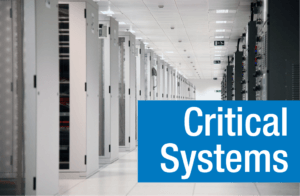
Air-side economizers
An air-side economizer system provides outside air to your data center. When outdoor air temperature and humidity levels are favorable, the outdoor air can reduce the need for mechanical cooling to cool your space. During cooler months when the humidity levels are low, humidifiers will be needed to maintain the proper humidity levels in your data center. Late fall, winter and early spring in the Southeast provide great opportunities to utilize an air-side economizer, and many sites are capable of utilizing them year-round by supplementing with some mechanical cooling to achieve significant energy savings.
Water-side economizers
Another option is water-side economizers. Typically, heat exchangers are used as water-side economizers in water-cooled chiller plants and can significantly reduce energy consumption of data center mechanical systems. Heat exchangers also provide optimal energy savings during the cooler seasons, but in the right arrangement, they can deliver nearly year-round savings. Any time that you can use a heat exchanger to reduce the need for mechanical cooling, you will drive big energy savings. Water-side economizers also provide great cooling capacity without exposing your data center to possible outside air contaminants. A heat exchanger does not require any power and transfers the heat from the data center load into the atmosphere to provide cooling and save energy. If you have a facility currently utilizing chiller and cooling tower line-ups, adding heat exchangers can be a cost effective way to reduce your energy load.
Heat exchangers can be configured to operate in two configurations: parallel (non-integrated) or series (integrated).
- Parallel configuration: The heat exchanger operates in parallel with the chiller to provide all of the cooling required. Parallel configured systems will primarily operate as a winter season economizer in the Southeast region because the outdoor temperature must be cold enough to not require any mechanical cooling.
- Series configuration: The heat exchanger can operate in conjunction with the chiller to provide energy savings in a wider range of outside temperatures and allow for more flexibility. With a series configuration, the heat exchanger can operate to provide all or part of the cooling load as required, and the chiller will operate to compensate for any additional cooling that is required. If your data center has multiple chillers, this can allow you to operate in partial economizer mode and reduce the number of chillers required to meet set point. Anytime you can reduce the number of chillers required to meet the cooling load of the data center, it will result in a major reduction in energy consumption.
Choosing an approach
There are many factors to consider when determining which system is the right one for your data centers and which design will provide the most energy savings. What are your needs for cooling and what will your current system benefit from the most? If your data center does not have an economizer, there is most likely an opportunity to utilize air-side or water-side economizers to reduce your power bill. McKenney’s is here to help you determine what economizer options will help to provide you with the optimal energy savings and optimize your data center’s functionality.
Have a question for our experts? Leave your comment below, check out our Building Services page or contact our team directly at critical.systems@mckenneys.com.




